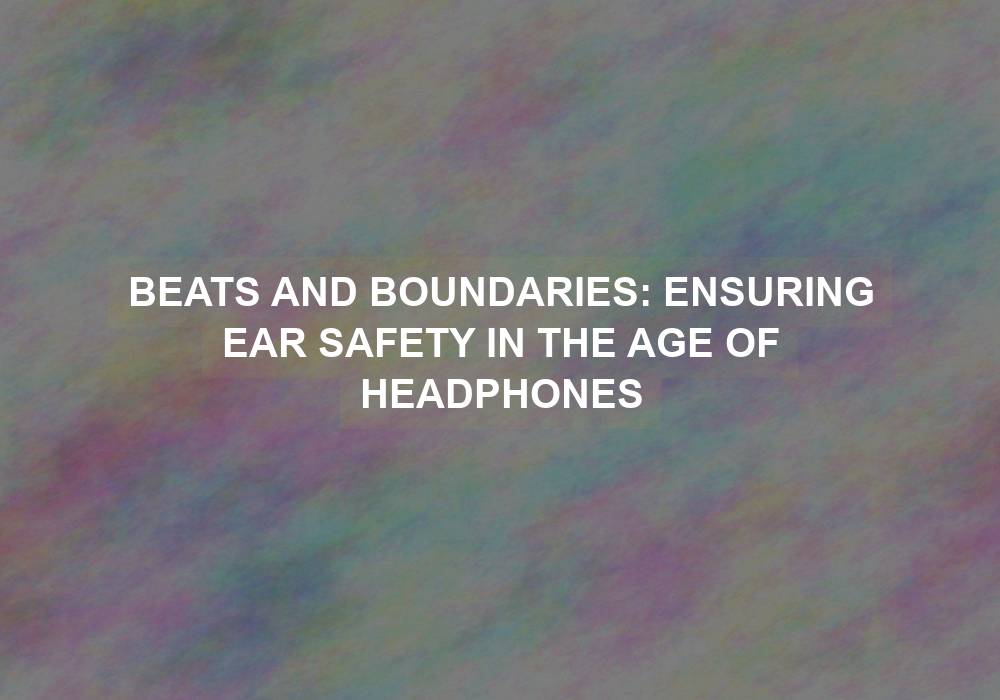In today’s digital era, headphones have become an integral part of our lives, providing us with a personalized audio experience. Whether we use them for listening to music, watching movies, or attending virtual meetings, headphones have revolutionized the way we consume audio content. However, amid this technological advancement, it is crucial to prioritize and ensure ear safety.
The Rise of Headphones
Headphones have gained immense popularity in recent years, with advancements in technology and the increasing accessibility of audio content. They offer a convenient and immersive audio experience, allowing us to enjoy our favorite music or podcasts anytime and anywhere.
With the rise of streaming platforms and the availability of high-quality audio content, headphones have become a staple accessory for many individuals. Whether it’s for entertainment purposes or professional use, headphones provide a level of personalization and privacy that traditional speakers cannot match.
Understanding the Risks
While headphones provide us with a pleasurable audio experience, it is important to be aware of the potential risks associated with prolonged and excessive headphone use. Here are some common risks to consider:
-
Hearing Loss: Exposing our ears to loud sounds for extended periods can lead to permanent hearing loss. The proximity of the sound source to our ears when using headphones increases the risk of damage. It is important to understand the safe volume levels and duration of exposure to prevent irreversible damage to our hearing.
-
Noise-Induced Hearing Loss (NIHL): Listening to music at high volumes or exposure to loud noises through headphones can cause NIHL. It occurs when the delicate hair cells in our ears are damaged due to excessive noise. These hair cells are responsible for converting sound vibrations into electrical signals that our brain can interpret. When they are damaged, our ability to hear decreases.
-
Tinnitus: Prolonged exposure to loud sounds can also result in tinnitus, a condition characterized by a persistent ringing or buzzing sensation in the ears. This can be highly discomforting and affect our overall well-being. Tinnitus can be temporary or chronic, and it is often a result of damage to the auditory system from exposure to loud noises.
-
Ear Infections: Wearing headphones for extended periods can create a warm and moist environment conducive to bacterial growth, increasing the risk of ear infections. It is essential to maintain proper hygiene and cleanliness of both our headphones and ears to minimize the risk of infections.
-
Misophonia: Some individuals may experience misophonia, a heightened sensitivity to certain sounds, when using headphones. This can cause stress, anxiety, and discomfort. Understanding our individual sensitivities and adjusting our headphone usage accordingly can help prevent any negative effects.
Best Practices for Ear Safety
To ensure ear safety while using headphones, it is important to follow these best practices:
1. Limit Exposure to Loud Sounds
Ensure that the volume level on your headphones is set at a safe level. The general rule of thumb is to listen at around 60% of the maximum volume for no more than 60 minutes at a time. Taking regular breaks from headphone use can also help reduce the risk of hearing damage. Additionally, be mindful of the ambient noise around you and adjust the volume accordingly to avoid the need for excessively loud playback.
2. Invest in High-Quality Headphones
Opt for headphones that prioritize sound quality and noise cancellation. High-quality headphones can deliver a better audio experience at lower volume levels, reducing the risk of hearing damage. Look for headphones with built-in volume limiters or noise-canceling features to protect your ears. It is worth investing in a reputable brand that offers reliable sound quality and prioritizes user safety.
3. Use Over-Ear Headphones
Over-ear headphones are generally considered safer than in-ear or on-ear alternatives. They provide better noise isolation and reduce the risk of hearing damage as they don’t need to be turned up as loud to block out external noise. Additionally, over-ear headphones distribute sound more evenly across the ear, minimizing the strain on specific areas and reducing the risk of discomfort or damage.
4. Maintain Proper Hygiene
Regularly clean your headphones to prevent the buildup of bacteria or earwax, which can lead to infections. Use a soft, dry cloth to wipe the headphones and avoid using harsh chemicals that may damage the device. It is also advisable to clean your ears regularly to minimize the risk of infections and ensure optimal ear health.
5. Encourage Safe Listening Practices
Educate yourself and others on the importance of safe listening practices. Encourage friends and family members, especially children and teenagers, to follow the recommended volume limits and take breaks from headphone use. By spreading awareness about the potential risks and promoting responsible listening habits, we can minimize the chances of hearing damage and related complications.
6. Monitor Volume Levels
Consider using smartphone apps or software that monitor your daily headphone usage and provide alerts when you exceed safe volume levels. This can help you maintain safe listening habits and prevent long-term damage to your ears. These monitoring tools can provide valuable insights into your listening habits and empower you to make informed decisions regarding your headphone usage.
7. Seek Professional Help if Necessary
If you experience any signs of hearing loss, tinnitus, or ear infections, consult with a healthcare professional specializing in audiology. They can assess your condition, provide appropriate treatment, and offer guidance on safe headphone use. It is essential to seek professional help if you notice any changes in your hearing or experience discomfort or abnormal sensations in your ears.
Conclusion
In conclusion, while headphones offer a convenient and immersive audio experience, it is crucial to prioritize ear safety. Understanding the risks associated with prolonged headphone use and implementing best practices can help protect your hearing and prevent potential long-term damage. By following these guidelines, you can enjoy the beats without compromising your boundaries. Remember, your hearing health is invaluable, so take the necessary precautions and make informed choices when it comes to headphone usage.
